Residential and Commercial Applications
Understanding Commercial-Grade Heat Pump Applications

Dealing with a malfunctioning HVAC system is a common headache for many people. However, when it comes to large commercial heat pumps, it’s a whole new challenge. Understanding how these systems work is crucial in order to effectively manage them.
In this article, we’ll delve into the key differences between residential and commercial heat pumps, factors to consider when choosing a system, best practices for installation, and maintenance tips.
Get ready to save time, money, and headaches with our comprehensive guide to commercial-grade heat pumps.
Key Takeaways
- Commercial-grade heat pumps provide both heating and cooling for year-round comfort.
- They are highly efficient, resulting in energy savings and reduced operating costs.
- Commercial heat pumps are more powerful and capable of heating or cooling larger spaces compared to residential heat pumps.
- While commercial heat pump applications are generally more expensive upfront, they are more cost-effective in the long run.
Overview of Commercial-Grade Heat Pumps
In this section, we’ll provide an overview of commercial-grade heat pumps.

Commercial heat pump systems offer a wide range of key features, benefits, and advantages that make them ideal for various applications. One key feature is their ability to provide both heating and cooling, allowing for year-round comfort. These heat pumps are designed to be highly efficient, resulting in energy savings and reduced operating costs. They also offer the advantage of being environmentally friendly, as they use renewable energy sources such as geothermal or air-to-water systems.
Common applications for commercial heat pump systems include heating and cooling large commercial buildings, such as office complexes, hotels, hospitals, and shopping centers. Additionally, they’re often used in industrial processes that require precise temperature control.
Key Differences Between Residential and Commercial Heat Pump Applications
While residential heat pump applications focus on individual homes, commercial heat pump applications are designed for larger-scale buildings and facilities. There are several key differences between residential and commercial heat pump applications, including performance and cost.
In terms of performance, commercial heat pumps are typically more powerful and capable of heating or cooling larger spaces compared to residential heat pumps. This is because commercial buildings often have higher heating and cooling demands due to their size and occupancy levels. Additionally, commercial heat pumps are designed to operate continuously and efficiently, even under heavy loads.
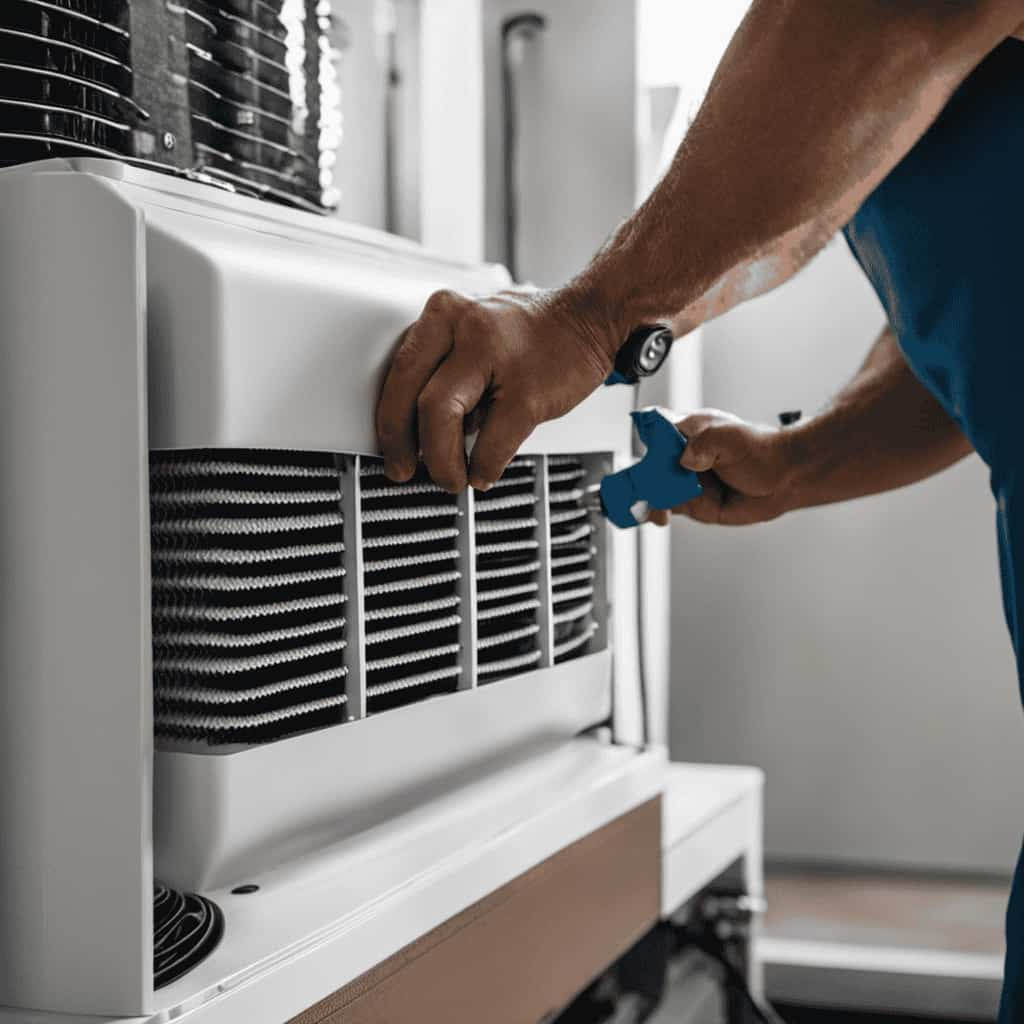
When it comes to cost, commercial heat pump applications are generally more expensive upfront compared to residential applications. This is because commercial heat pumps are larger and require more complex installation and maintenance. However, commercial heat pumps are often more cost-effective in the long run due to their higher efficiency and ability to serve larger areas.
To illustrate the differences between residential and commercial heat pump applications, let’s compare them in the following table:
| Aspect | Residential Heat Pump Applications | Commercial Heat Pump Applications |
|---|---|---|
| Performance | Suitable for individual homes | Suitable for larger buildings |
| Cost | Lower upfront cost | Higher upfront cost |
| Efficiency | Lower overall efficiency | Higher overall efficiency |
| Installation Complexity | Less complex | More complex |
Factors to Consider When Choosing a Commercial Heat Pump System
When choosing a commercial heat pump system, there are several factors to consider.
First, it’s important to look at the energy efficiency ratings of the system. This will determine how effectively the heat pump can convert energy into heat or cool air.

Additionally, the installation and maintenance requirements should be taken into account, as these can affect the overall cost and lifespan of the system.
Lastly, the heating and cooling capacity of the heat pump should be evaluated to ensure it can adequately meet the needs of the commercial space.
Energy Efficiency Ratings
One important factor to consider when choosing a commercial heat pump system is its energy efficiency rating. Energy efficiency benefits both the environment and your business by reducing energy consumption and lowering utility costs. To determine the energy efficiency of a heat pump system, it is essential to look at its energy ratings. These ratings provide valuable information about the system’s performance and indicate how effectively it converts electricity into heating or cooling. The most common energy efficiency ratings for heat pumps are the Seasonal Energy Efficiency Ratio (SEER) and the Heating Seasonal Performance Factor (HSPF). SEER measures cooling efficiency, while HSPF measures heating efficiency. Higher SEER and HSPF ratings indicate better energy efficiency. When comparing different heat pump systems, it is crucial to consider their energy efficiency ratings to make an informed decision that aligns with your business’s energy-saving goals.
| Energy Efficiency Rating | Description |
|---|---|
| SEER | Measures cooling efficiency and indicates how well the system converts electricity into cooling. Higher SEER ratings mean better energy efficiency. |
| HSPF | Measures heating efficiency and indicates how well the system converts electricity into heating. Higher HSPF ratings mean better energy efficiency. |
Installation and Maintenance
We frequently evaluate installation and maintenance factors when choosing a commercial heat pump system. Proper installation is crucial to ensure optimal performance and energy efficiency. Some installation challenges to consider include:

- Site suitability: Assessing if the site meets the requirements for adequate space, ventilation, and accessibility for installation.
- Electrical requirements: Determining if the electrical system can support the heat pump’s power demands.
- System integration: Ensuring seamless integration with existing HVAC systems and controls.
- Water source availability: Confirming the availability of an appropriate water source, such as a well or lake, for water-source heat pump systems.
- Noise considerations: Addressing noise concerns to minimize disruptions in commercial settings.
Maintenance is also essential to keep the heat pump system running smoothly. Common maintenance issues include:
- Regular filter cleaning or replacement to maintain proper airflow.
- Inspecting and cleaning coils to prevent dirt buildup and maintain optimal heat transfer.
- Checking refrigerant levels and ensuring there are no leaks.
- Lubricating motors and bearings to reduce friction and extend their lifespan.
- Conducting routine inspections and preventive maintenance to identify and address any issues before they escalate.
Heating and Cooling Capacity
To accurately select a commercial heat pump system, we must consider the heating and cooling capacity requirements. This involves conducting a heating and cooling load calculation to determine the amount of heat that needs to be added or removed from a space. The calculation takes into account factors such as the size of the space, insulation levels, and geographical location.
By analyzing the heat pump performance, we can determine if the system is capable of meeting the required heating and cooling capacity. This analysis considers factors such as the coefficient of performance (COP) and energy efficiency ratio (EER) of the heat pump.
It’s crucial to choose a heat pump system that can handle the heating and cooling demands of the specific commercial application to ensure optimal comfort and energy efficiency.

Best Practices for Installing Commercial-Grade Heat Pumps
When it comes to installing commercial-grade heat pumps, there are several best practices that should be followed.
Firstly, careful consideration must be given to the location and placement of the heat pump, taking into account factors such as accessibility, noise levels, and potential obstructions.
Secondly, proper sizing requirements should be determined to ensure that the heat pump is able to effectively meet the heating and cooling demands of the space.
Lastly, regular maintenance and servicing are essential to ensure the longevity and optimal performance of the heat pump system.

Location and Placement
The location and placement of commercial-grade heat pumps are crucial factors to consider for optimal installation. Proper placement considerations ensure efficient operation and maximum performance. Here are some optimal locations to keep in mind:
-
Proximity to the load: Placing the heat pump close to the area it serves reduces heat loss in the distribution system.
-
Accessibility for maintenance: Easy access to the heat pump allows for regular inspections and servicing, ensuring its longevity.
-
Avoiding direct sunlight: Shielding the heat pump from direct sunlight prevents overheating and potential damage.

-
Avoiding obstructions: Placing the heat pump away from obstructions such as trees or walls ensures adequate airflow and prevents blockages.
-
Noise reduction: Locating the heat pump away from sensitive areas or using sound barriers minimizes any potential noise disruptions.
Considering these factors during the installation process will help optimize the performance and longevity of commercial-grade heat pumps, ensuring reliable heating and cooling for your establishment.
Proper Sizing Requirements
We recommend considering the facility’s specific heating and cooling needs and selecting the appropriate size of the commercial-grade heat pump to ensure efficient operation. Proper sizing techniques are crucial in achieving optimal performance and energy efficiency.

When it comes to sizing commercial-grade heat pumps, it’s essential to follow industry standards for sizing to avoid under or oversized units. Undersized units may struggle to meet the facility’s heating and cooling demands, resulting in poor performance and increased energy consumption. On the other hand, oversized units can lead to frequent cycling, inefficient operation, and unnecessary wear and tear.
To determine the proper size, factors such as the building’s square footage, insulation levels, and climate conditions must be considered. Consulting with a professional HVAC contractor who’s knowledgeable about industry standards for sizing is highly recommended to ensure accurate sizing and efficient operation of the commercial-grade heat pump.
Maintenance and Servicing
Our team recommends regular maintenance and servicing for optimal performance and longevity of commercial-grade heat pumps. By implementing preventive maintenance, you can minimize the risk of common servicing issues and ensure the smooth operation of your heat pump system.
Here are some key practices to keep in mind:

- Schedule regular inspections and cleanings to remove any debris or dirt that may obstruct airflow and reduce efficiency.
- Check and replace air filters regularly to maintain good indoor air quality and prevent strain on the system.
- Monitor refrigerant levels and ensure they’re within the manufacturer’s recommended range to prevent cooling or heating issues.
- Inspect electrical connections and components to identify any signs of wear or damage that may lead to system failure.
- Lubricate moving parts to reduce friction and noise and extend the lifespan of your heat pump.
By following these maintenance practices, you can prolong the life of your commercial-grade heat pump and prevent potential issues.
In the next section, we’ll provide maintenance and troubleshooting tips for commercial heat pump applications.
Maintenance and Troubleshooting Tips for Commercial Heat Pump Applications
To effectively maintain and troubleshoot commercial heat pump applications, we need to understand the key components and potential issues that can arise. Regular maintenance schedules are crucial to ensure optimal performance and prevent costly breakdowns.
Some common troubleshooting techniques include checking for power supply issues, inspecting and cleaning filters, and examining the refrigerant levels. It’s important to regularly inspect and clean the outdoor unit, as debris accumulation can hinder airflow and reduce efficiency.

Additionally, monitoring the temperature and pressure differentials can help identify potential issues such as refrigerant leaks or compressor failures. By following proper maintenance procedures and promptly addressing any troubleshooting needs, commercial heat pump applications can operate efficiently and reliably, providing comfort and satisfaction to customers.
Energy Efficiency and Cost Savings With Commercial Heat Pumps
Commercial heat pumps offer significant energy efficiency and cost savings, making them an ideal choice for businesses looking to reduce their energy consumption and expenses. With the rising costs of energy and increasing concerns about environmental sustainability, investing in cost-effective solutions like commercial heat pumps can have a positive impact both on the bottom line and the planet.
Here are some key benefits of using commercial heat pumps:
-
Reduced energy consumption: Commercial heat pumps utilize renewable energy sources, such as the air or ground, to provide heating and cooling, resulting in lower energy usage and reduced utility bills.

-
Lower carbon footprint: By relying on renewable energy, commercial heat pumps help reduce greenhouse gas emissions and contribute to a more sustainable environment.
-
Long-term cost savings: Although the initial investment in commercial heat pumps may be higher, the long-term cost savings from reduced energy consumption can outweigh the upfront costs.
-
Increased comfort: Commercial heat pumps provide consistent heating and cooling throughout the year, ensuring a comfortable indoor environment for employees and customers.
-
Government incentives: Many governments offer incentives and rebates for businesses that invest in energy-efficient technologies like commercial heat pumps, further enhancing cost savings.
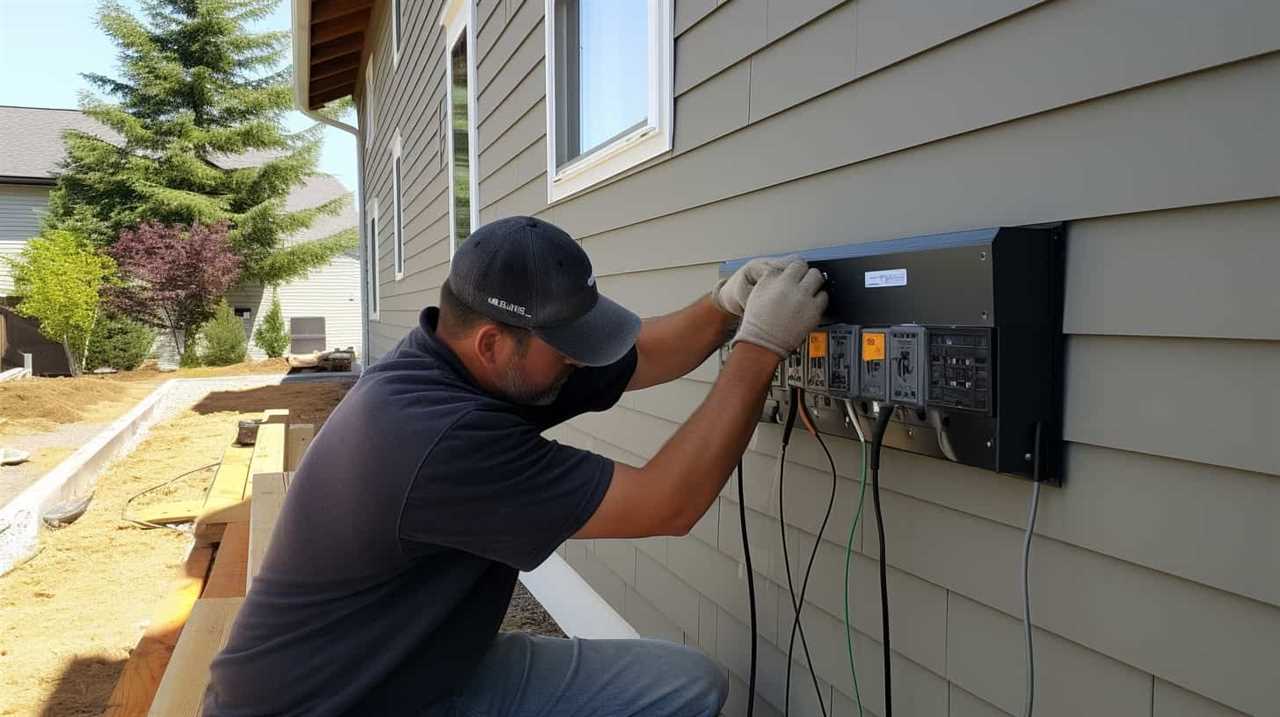
Case Studies: Successful Commercial Heat Pump Installations
We have gathered case studies of successful commercial heat pump installations to provide real-world examples of the benefits and effectiveness of this technology. These case studies highlight the various applications and industries where commercial heat pumps have been successfully implemented, showcasing their versatility and efficiency.
| Case Study | Industry | Benefits |
|---|---|---|
| Case Study 1 | Retail | Reduced energy costs by 30% |
| Case Study 2 | Hospitality | Improved heating and cooling control |
| Case Study 3 | Healthcare | Enhanced indoor air quality |
| Case Study 4 | Education | Lowered carbon footprint |
In Case Study 1, a retail store was able to significantly reduce their energy costs by 30% after installing a commercial heat pump system. This not only resulted in substantial financial savings but also contributed to a more sustainable operation.
In Case Study 2, a hospitality establishment experienced improved heating and cooling control, ensuring optimal comfort for their guests throughout the year. This led to higher customer satisfaction and positive reviews.
Case Study 3 focused on a healthcare facility that installed a commercial heat pump system to enhance indoor air quality. The heat pump’s advanced filtration system effectively removed pollutants and allergens, creating a healthier environment for patients and staff.

Lastly, Case Study 4 showcased how a school implemented a commercial heat pump system to lower their carbon footprint. This sustainable solution aligned with their commitment to environmental stewardship and provided a valuable educational opportunity for students.
These successful case studies demonstrate the wide range of benefits that commercial heat pump installations can offer across various industries. Whether it’s reducing energy costs, improving comfort control, enhancing indoor air quality, or promoting sustainability, commercial heat pumps prove to be an effective and efficient solution for businesses seeking to optimize their heating and cooling systems.
Frequently Asked Questions
What Is the Average Lifespan of a Commercial-Grade Heat Pump?
The average lifespan of a commercial-grade heat pump depends on the manufacturer and maintenance requirements. Regular maintenance can extend its lifespan.
How Much Noise Does a Commercial-Grade Heat Pump Typically Make?
Commercial-grade heat pumps can produce varying noise levels depending on factors such as unit size, location, and sound insulation. Understanding commercial-grade heat pump noise levels is crucial for selecting the right unit for a noise-sensitive environment.

Are There Any Government Incentives or Rebates Available for Installing Commercial Heat Pump Systems?
Yes, there are government incentives and rebates available for installing commercial heat pump systems. These incentives are aimed at promoting energy efficiency, providing cost savings, and supporting the installation process.
Can a Commercial-Grade Heat Pump Be Used for Both Heating and Cooling Purposes?
Yes, a commercial-grade heat pump can be used for both heating and cooling purposes. It offers high efficiency and numerous benefits, such as reduced energy consumption and lower operating costs.
What Is the Typical Payback Period for a Commercial Heat Pump Installation?
The typical payback period for a commercial heat pump installation depends on factors such as energy efficiency benefits and typical maintenance requirements. It is important to consider these factors when evaluating the cost-effectiveness of the investment.
Conclusion
In conclusion, commercial-grade heat pumps are a highly efficient and cost-effective solution for heating and cooling large spaces. They offer significant energy savings and can be tailored to meet specific needs.

However, it’s crucial to consider factors such as system size, installation best practices, and regular maintenance to ensure optimal performance. Like a well-oiled machine, a properly installed and maintained commercial heat pump can seamlessly regulate temperature, just like a conductor leading an orchestra to perfect harmony.
Residential and Commercial Applications
Unveiling Energy-Efficient Heat Pumps: Residential & Commercial Study

Attention everyone, prepare yourselves for a revolutionary breakthrough in the realm of energy conservation. We are thrilled to present our in-depth analysis on energy-efficient heat pumps, with the goal of revolutionizing the way we regulate temperature in residential and commercial settings.
Join us as we delve into the countless benefits and advantages of these cutting-edge devices. With our expert analysis and real-life case studies, we will show you how energy-efficient heat pumps can lower your bills, enhance comfort, and improve indoor air quality.
Get ready to embark on a journey of transformation and savings.
Key Takeaways
- Energy-efficient heat pumps offer significant energy savings through advanced technology, reducing reliance on traditional heating methods and lowering utility bills.
- These heat pumps provide efficient heating and cooling throughout the year, maintaining a consistent indoor temperature for further energy savings.
- In commercial applications, energy-efficient heat pumps can result in significant cost savings and environmental benefits.
- By utilizing renewable energy sources, these heat pumps contribute to a greener future, reducing greenhouse gas emissions and minimizing environmental impact.
Benefits of Energy-Efficient Heat Pumps in Residential Settings
We’re going to explore the benefits of using energy-efficient heat pumps in residential settings.

Energy efficient heat pumps for apartments and residential buildings offer significant advantages in terms of energy savings. These heat pumps utilize advanced technology to extract heat from the air or ground and transfer it into the building. By doing so, they reduce the reliance on traditional heating methods that consume large amounts of electricity or fossil fuels.
This results in substantial energy savings for homeowners and tenants, leading to lower utility bills and reduced environmental impact. Additionally, energy-efficient heat pumps provide efficient heating and cooling throughout the year, ensuring comfort in all seasons. Their ability to operate at high efficiency levels helps to maintain a consistent indoor temperature, further contributing to energy savings.
Advantages of Energy-Efficient Heat Pumps in Commercial Applications
The advantages of energy-efficient heat pumps in commercial applications are numerous, providing significant cost savings and environmental benefits. In industrial facilities, where large-scale heating and cooling requirements are essential, energy-efficient heat pumps offer a compelling solution.
These heat pumps are designed to efficiently transfer heat from one location to another, using minimal energy input. By harnessing the ambient heat from the surrounding environment, they can provide heating during winter months and cooling during summer months, all while consuming less energy compared to traditional heating and cooling systems. This not only reduces energy costs but also contributes to a significant reduction in greenhouse gas emissions.

Additionally, energy-efficient heat pumps are highly reliable and require minimal maintenance, making them an ideal choice for commercial applications where uninterrupted operation is crucial.
Key Features and Specifications of Energy-Efficient Heat Pumps for Homes
Our study explores the key features and specifications of energy-efficient heat pumps for homes, providing valuable insights for homeowners looking to invest in sustainable heating and cooling solutions.
When considering energy-efficient heat pumps for your home, there are several important features and considerations to keep in mind:
- Seasonal Energy Efficiency Ratio (SEER) and Heating Seasonal Performance Factor (HSPF) ratings, which indicate the unit’s energy efficiency.
- Variable-speed compressors and fans, which allow for more precise temperature control and reduce energy consumption.
- Noise levels, as low-noise operation is important for maintaining a comfortable living environment.
- Compatibility with existing HVAC systems, ensuring seamless integration and maximizing energy savings.
- Energy-efficient heat pump maintenance, such as regular filter cleaning and professional servicing, to ensure optimal performance and longevity.
Additionally, it’s worth noting that government incentives for energy-efficient heat pumps may be available, further reducing the initial investment cost.

With these key features and incentives in mind, let’s now explore how energy-efficient heat pumps can lower residential energy bills.
How Energy-Efficient Heat Pumps Can Lower Residential Energy Bills
Installing energy-efficient heat pumps can significantly lower residential energy bills. These advanced heating and cooling systems utilize renewable energy sources, such as the air or ground, to efficiently regulate indoor temperature.
By operating at higher efficiencies, energy-efficient heat pumps consume less electricity, resulting in reduced energy usage and lower utility bills for homeowners. This not only provides significant cost savings in the long run but also contributes to lowering the carbon footprint and minimizing the environmental impact.
The reduced energy consumption of energy-efficient heat pumps directly translates to decreased greenhouse gas emissions, making them an environmentally friendly choice. Additionally, the improved energy efficiency of these heat pumps aligns with the increasing demand for sustainable and eco-friendly solutions, allowing homeowners to actively contribute to a greener future.

Enhancing Comfort and Indoor Air Quality With Energy-Efficient Heat Pumps in Commercial Spaces
By utilizing energy-efficient heat pumps in commercial spaces, we can greatly improve comfort and indoor air quality while reducing energy consumption. Energy-efficient heat pumps offer a range of benefits that contribute to a more pleasant and healthier environment for both employees and customers.
Here are two ways in which these cooling solutions enhance comfort and indoor air quality:
-
Enhanced temperature control: Energy-efficient heat pumps provide precise temperature control, allowing commercial spaces to maintain a comfortable and consistent temperature throughout the day. This eliminates hot and cold spots, ensuring a more enjoyable experience for everyone inside the building.
-
Improved air filtration: Energy-efficient heat pumps are equipped with advanced air filtration systems that remove dust, allergens, and other pollutants from the air. This helps to improve indoor air quality and create a healthier environment for employees and customers.

Case Studies: Successful Implementation of Energy-Efficient Heat Pumps in Residential Projects
In examining the successful implementation of energy-efficient heat pumps in residential projects, we’ll focus on two key points:
Cost savings and efficiency: By analyzing the financial benefits and energy efficiency improvements achieved through the use of these heat pumps, we can gain insight into their effectiveness in residential settings.
Real-life user experiences: Additionally, by exploring the experiences of actual users, we can better understand the practical advantages and challenges of integrating energy-efficient heat pumps into residential projects.
Cost Savings and Efficiency
We have observed significant cost savings and improved energy efficiency in residential projects through the successful implementation of energy-efficient heat pumps.

By incorporating these energy-saving tips, homeowners can enjoy reduced utility bills and minimize their environmental impact:
-
Proper insulation: Ensuring that your home is well-insulated helps to maintain a consistent temperature, reducing the workload on your heat pump.
-
Regular maintenance: Regularly servicing your heat pump can help maintain its efficiency and prevent costly breakdowns.
-
Smart thermostat: Installing a programmable thermostat allows you to schedule temperature changes based on when you’re at home, saving energy when you’re away.

-
Zoning systems: Implementing zoning systems allows you to heat or cool specific areas of your home, reducing energy waste in unused rooms.
Implementing these measures not only leads to substantial cost savings but also helps to protect the environment by reducing energy consumption and greenhouse gas emissions.
Real-Life User Experiences
Our research has revealed numerous real-life user experiences that demonstrate the successful implementation of energy-efficient heat pumps in residential projects. These case studies provide valuable insights into the real-world applications of energy-efficient heat pumps and highlight the high level of user satisfaction they can deliver.
In one case study, a family living in a cold climate reported significant cost savings and improved comfort after installing an energy-efficient heat pump in their home. They were particularly impressed with the consistent heating performance and the ability to customize temperature settings in different rooms.

Another case study involved a homeowner who’d previously relied on traditional heating systems. After switching to an energy-efficient heat pump, they noticed a remarkable reduction in energy consumption and a more even distribution of heat throughout their home.
These real-life user experiences showcase the practical benefits of energy-efficient heat pumps and the positive impact they can have on residential energy consumption and user satisfaction.
Transitioning into the subsequent section, we’ll now discuss the best practices for choosing and installing energy-efficient heat pumps in commercial buildings.
Best Practices for Choosing and Installing Energy-Efficient Heat Pumps in Commercial Buildings
To ensure optimal performance and energy efficiency, selecting and installing the right heat pump system is crucial for commercial buildings. When choosing energy-efficient models, there are several factors to consider.

Here are some best practices for choosing and installing energy-efficient heat pumps in commercial buildings:
-
Research and compare energy efficiency ratings: Look for heat pump systems with high Seasonal Energy Efficiency Ratio (SEER) and Heating Seasonal Performance Factor (HSPF) ratings. These ratings indicate how efficiently the system can cool and heat the building.
-
Consider the heating and cooling needs: Evaluate the specific heating and cooling requirements of the commercial building. This includes factors such as the size of the space, insulation levels, and climate conditions.
-
Size and capacity: Ensure the heat pump system is appropriately sized for the building to avoid inefficiencies or inadequate heating and cooling.

-
Installation considerations: Plan the installation process carefully, considering factors such as the location of the heat pump unit, ductwork design, and airflow optimization.
Frequently Asked Questions
What Is the Average Cost of Installing an Energy-Efficient Heat Pump in a Residential Setting?
The average installation cost of an energy-efficient heat pump in a residential setting can vary depending on factors such as size and efficiency. However, there are available incentives that can help offset these costs.
Are There Any Government Incentives or Rebates Available for Homeowners Who Choose to Install Energy-Efficient Heat Pumps?
There are government incentives and rebates available for homeowners who choose to install energy-efficient heat pumps. These financial benefits can help offset the cost of installation and make it more affordable for homeowners.
Can Energy-Efficient Heat Pumps Be Used in Both New Construction and Existing Homes?
Installing energy-efficient heat pumps is feasible for both new construction and existing homes. We analyze cost-effectiveness, comparing new installations to retrofits. Additionally, we assess the impact on energy bills for both types of homes.
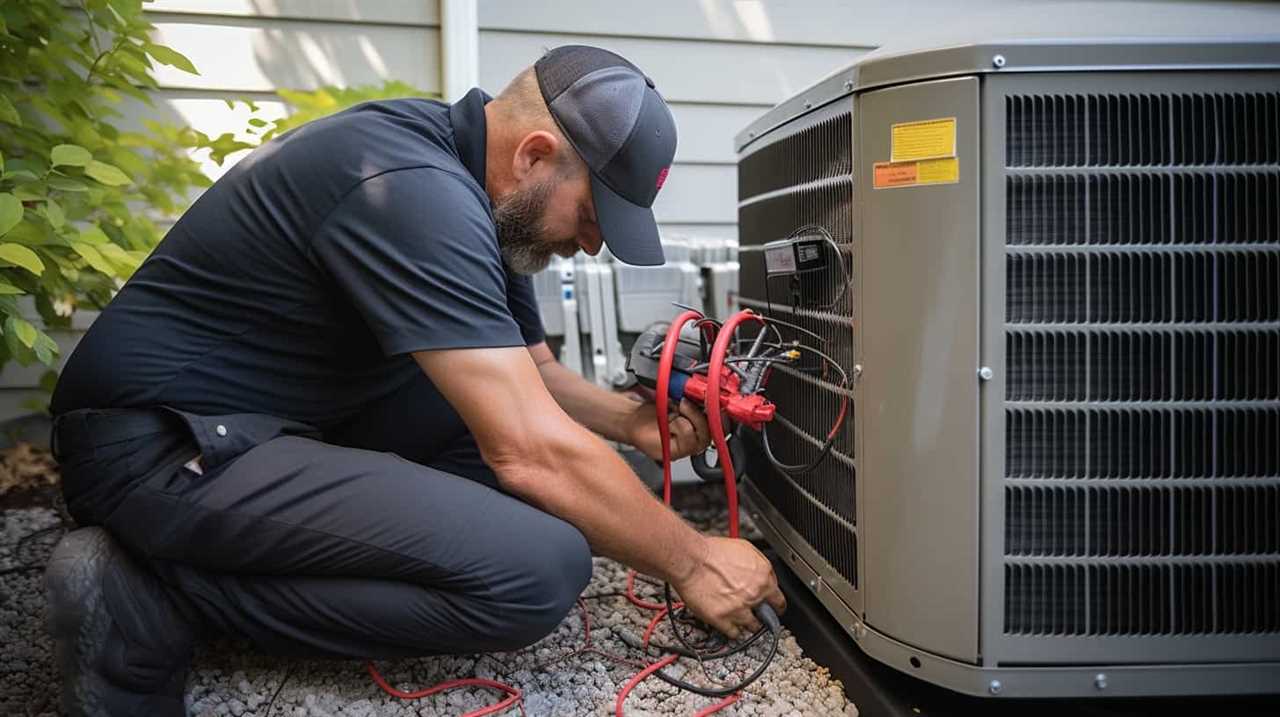
How Long Does the Average Energy-Efficient Heat Pump Last Before It Needs to Be Replaced?
Energy-efficient heat pumps have a significant longevity, with an average replacement frequency that varies depending on factors such as usage, maintenance, and environmental conditions. Understanding these factors is crucial for ensuring optimal performance and cost-effectiveness.
Are There Any Maintenance Requirements or Regular Servicing Needed for Energy-Efficient Heat Pumps in Residential Settings?
In residential settings, energy-efficient heat pumps require regular maintenance and servicing to ensure optimal performance. These maintenance requirements are essential for prolonging the lifespan of the heat pump and maximizing its energy efficiency.
Conclusion
In conclusion, the implementation of energy-efficient heat pumps in both residential and commercial settings offers numerous benefits. These heat pumps not only lower energy bills but also enhance comfort and indoor air quality.
Through successful case studies and best practices for installation, it’s evident that energy-efficient heat pumps are a reliable and cost-effective solution. By incorporating these pumps, individuals and businesses can achieve optimal energy efficiency and contribute to a sustainable future.

Residential and Commercial Applications
Why Commercial Grade Heat Pumps Are Essential

Did you know that industrial-grade heat pumps have the potential to cut heating and cooling costs for businesses in half? These durable systems are not only cost-effective but also reliable, efficient, and built to last.
In our article, we will explore the multitude of benefits that commercial grade heat pumps offer, from their superior performance to their versatility and adaptability.
Join us as we uncover why these heat pumps are essential for businesses looking to serve others while maximizing their resources.
Key Takeaways
- Commercial grade heat pumps can save businesses up to 50% on heating and cooling costs.
- They provide long-term cost savings through reduced energy consumption and lower utility bills.
- Commercial grade heat pumps offer durability and reliability, with a lower environmental impact compared to traditional heating systems.
- They deliver consistent and reliable heating performance, while also reducing reliance on fossil fuels and contributing to a cleaner future.
The Benefits of Commercial Grade Heat Pumps
We believe that the efficiency of commercial grade heat pumps is a significant advantage for businesses. These heat pumps are designed to provide optimal heating and cooling solutions while minimizing energy consumption.
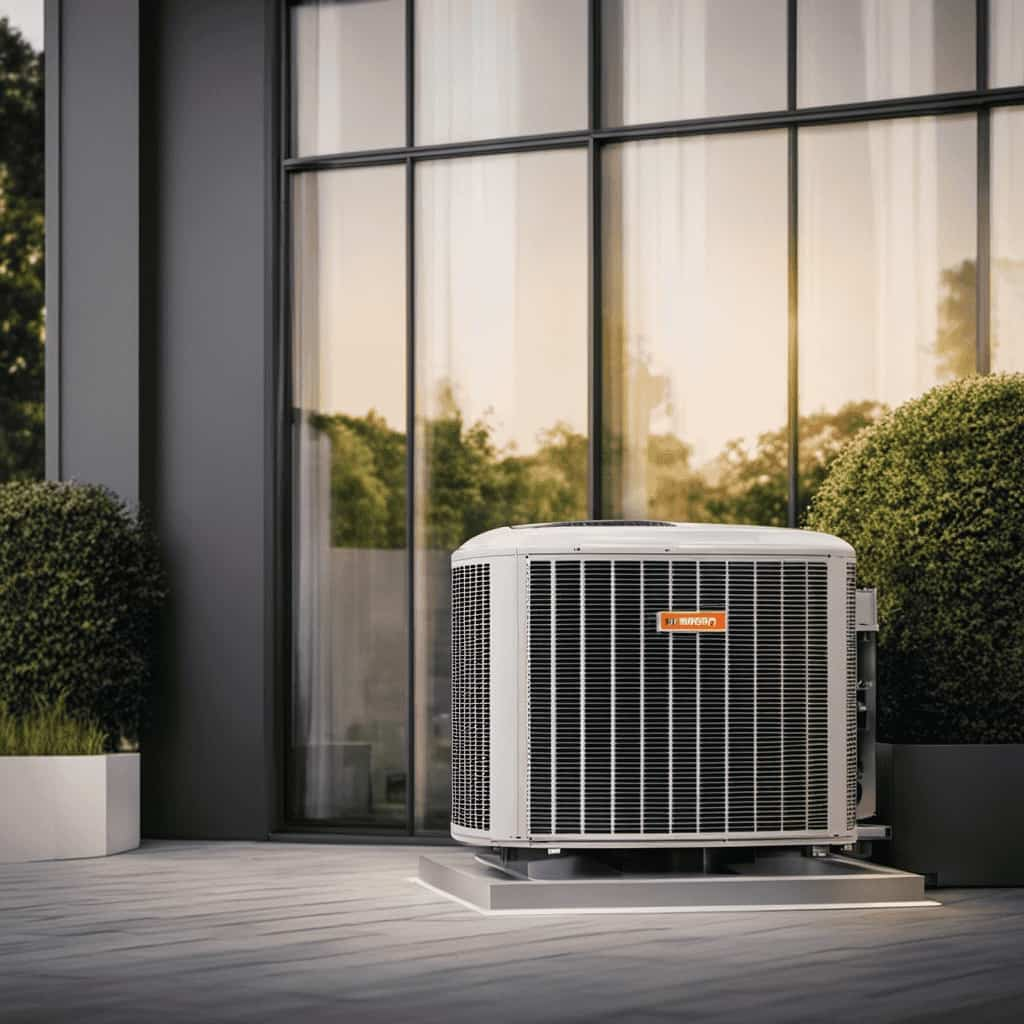
With their advanced technology, commercial grade heat pumps can save businesses a substantial amount of money on energy bills. This is particularly important in today’s world, where energy savings and environmental impact are major concerns.
By utilizing these heat pumps, businesses can reduce their carbon footprint and contribute to a greener environment. Furthermore, the energy savings achieved through the use of commercial grade heat pumps can be reinvested back into the business, allowing for growth and expansion.
Cost Efficiency of Commercial Grade Heat Pumps
While commercial grade heat pumps may have a higher upfront cost, they ultimately provide long-term savings through reduced energy consumption and lower utility bills. Investing in these heat pumps can lead to significant energy savings, which not only benefit businesses financially but also have a positive environmental impact. Consider the following benefits:
-
Reduced energy consumption:

-
Commercial grade heat pumps are designed to be highly efficient, using less energy to provide the same level of heating or cooling.
-
This results in lower energy bills and reduced reliance on fossil fuels, helping to mitigate climate change.
-
Lower utility bills:
-
By using less energy, commercial grade heat pumps can significantly reduce monthly utility bills.
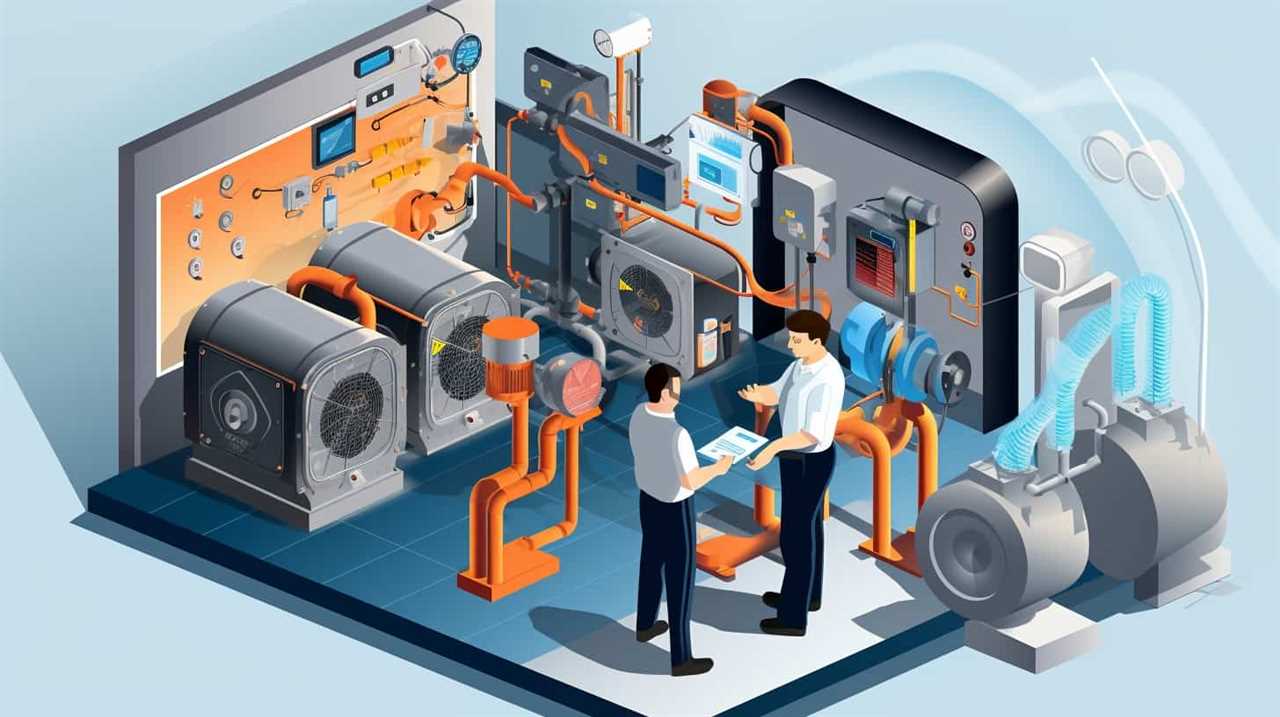
-
These cost savings can be redirected towards other business expenses or used to invest in further energy-efficient technologies.
Choosing commercial grade heat pumps not only improves cost efficiency but also demonstrates a commitment to sustainability and responsible energy usage. By embracing these technologies, businesses can contribute to a greener future while enjoying long-term financial benefits.
Durability and Reliability of Commercial Grade Heat Pumps
With proper maintenance and regular servicing, commercial grade heat pumps offer long-lasting durability and reliable performance. These heat pumps are designed to withstand the demands of commercial applications and are built with high-quality materials and components.
The longevity of commercial grade heat pumps can be ensured by adhering to a regular maintenance schedule, which includes cleaning and inspecting the system, checking for any leaks or malfunctions, and replacing any worn-out parts. By investing in proper maintenance, businesses can extend the lifespan of their heat pumps and avoid costly repairs or replacements.

Additionally, commercial grade heat pumps have a lower environmental impact compared to traditional heating systems, as they use renewable energy sources such as air or ground heat. This makes them a sustainable choice for businesses looking to reduce their carbon footprint.
Transitioning into the next section, the performance and energy efficiency of commercial grade heat pumps are also key factors to consider.
Performance and Energy Efficiency of Commercial Grade Heat Pumps
The performance and energy efficiency of our commercial grade heat pumps are crucial factors to consider when choosing the right heating system for your business. Here are some important points to keep in mind:
-
Performance optimization:

-
Our heat pumps are designed to deliver consistent and reliable heating performance, ensuring that your business stays comfortable throughout the year.
-
With advanced technology and smart controls, our heat pumps can adapt to changing conditions, optimizing their performance and maximizing energy savings.
-
Environmental impact:
-
Our commercial grade heat pumps are environmentally friendly, using renewable energy sources such as air or ground heat to heat your business.

-
By reducing your reliance on fossil fuels, you can significantly lower your carbon footprint and contribute to a cleaner, greener future.
Choosing a commercial grade heat pump with excellent performance and energy efficiency not only benefits your business but also helps protect the environment. So make the right choice for your heating needs and join us in creating a sustainable future.
Versatility and Adaptability of Commercial Grade Heat Pumps
We frequently encounter commercial grade heat pumps that offer versatility and adaptability to meet the diverse heating needs of businesses. These pumps are designed to be highly flexible, allowing for easy integration into existing heating systems and accommodating various heating requirements. With their adjustable settings and multiple operating modes, commercial grade heat pumps can efficiently deliver both heating and cooling, making them suitable for a wide range of environments and climates.
To illustrate the versatility and adaptability of these heat pumps, consider the following table:

| Features | Benefits |
|---|---|
| Adjustable | Allows for precise temperature control and energy savings |
| Multi-zone | Enables individual temperature regulation in different areas |
| Hybrid capability | Can integrate with other heating systems for enhanced efficiency |
Frequently Asked Questions
Are Commercial Grade Heat Pumps Suitable for Residential Use?
Commercial grade heat pumps are not suitable for residential use due to their high cost and excessive power. However, there are various residential heat pump options available that offer cost-effective and efficient heating and cooling solutions.
Can Commercial Grade Heat Pumps Be Used in Extreme Weather Conditions?
Using commercial grade heat pumps in remote areas allows us to effectively regulate indoor temperatures. These pumps have the ability to withstand extreme temperatures, ensuring optimal performance even in the harshest weather conditions.
What Maintenance Is Required for Commercial Grade Heat Pumps?
Regular maintenance for commercial grade heat pumps brings numerous benefits. It helps identify and address common issues promptly, preventing costly breakdowns. Troubleshooting techniques ensure optimal performance, prolonging the lifespan of these essential heating and cooling systems.
Are There Any Government Incentives or Rebates Available for Installing Commercial Grade Heat Pumps?
Government incentives and rebates are available for installing commercial grade heat pumps. These incentives aim to promote energy savings and encourage businesses to adopt more efficient heating systems. Take advantage of these opportunities to lower costs and reduce environmental impact.

How Long Is the Average Lifespan of a Commercial Grade Heat Pump?
On average, commercial grade heat pumps have a lifespan of 15-20 years. However, this can vary depending on the amount of maintenance required. Proper care and regular servicing can extend the life of the heat pump.
Conclusion
In conclusion, commercial grade heat pumps are the superheroes of the heating and cooling world. They not only save businesses money with their cost efficiency, but they also possess the durability and reliability to withstand the toughest conditions.
With their impressive performance and energy efficiency, these heat pumps are like the Olympic athletes of HVAC systems. And let’s not forget their versatility and adaptability, allowing them to conquer any climate or environment.
Investing in commercial grade heat pumps is a no-brainer for any business looking to save money and stay comfortable.

Residential and Commercial Applications
Ultimate Guide: Commercial Grade Heat Pump Applications

We have the ultimate guide just for you! Get ready to explore the world of commercial-grade heat pump applications.
Did you know that commercial grade heat pumps can save you up to 50% on your energy bills? In this detailed article, we’ll walk you through the basics, help you choose the right heat pump, and show you how to optimize its performance.
Whether you’re a homeowner or a business owner, we’ve got you covered. Let’s get started!
Key Takeaways
- Commercial grade heat pumps are designed for larger loads and offer advanced controls and monitoring capabilities, making them more efficient and reliable.
- When choosing a commercial grade heat pump, it is important to consider cost factors, environmental impact, long-term cost-effectiveness, and specific building requirements.
- Commercial grade heat pumps offer benefits in residential applications such as enhanced energy efficiency, increased durability, improved comfort, and the ability to meet the heating and cooling needs of larger spaces.
- There are different types of commercial grade heat pumps, including air source, water source, and ground source heat pumps, each offering their own advantages in terms of energy efficiency, performance, and environmental friendliness.
Understanding the Basics of Commercial Grade Heat Pumps
Now that we’ve covered the various applications of commercial grade heat pumps, let’s delve into understanding the basics of these systems.

Commercial heat pump technology advancements have made significant progress in recent years, allowing for more efficient and reliable heating and cooling solutions for commercial buildings. When comparing commercial and residential heat pump systems, there are several key differences to consider.
Commercial systems are designed to handle larger loads and are built with more robust components to withstand the demands of commercial use. They also have more advanced controls and monitoring capabilities to ensure optimal performance and energy efficiency. Additionally, commercial heat pumps often offer greater flexibility in terms of installation options and can be customized to meet the specific needs of the building.
Understanding these differences is crucial when considering key considerations for choosing a commercial grade heat pump, which we’ll explore in the next section.
Key Considerations for Choosing a Commercial Grade Heat Pump
When selecting a commercial grade heat pump, we must carefully consider several key factors to ensure the best choice for our specific needs.

One of the most important considerations is the cost. Commercial grade heat pumps can vary significantly in terms of upfront costs, operational costs, and maintenance costs. It’s crucial to evaluate the long-term cost-effectiveness of the heat pump, taking into account factors such as energy efficiency and potential savings on utility bills.
Additionally, the environmental impact of the heat pump should be taken into consideration. Look for heat pumps that are energy efficient and use environmentally friendly refrigerants. Consider the heat pump’s carbon footprint and its potential contribution to greenhouse gas emissions.
Benefits of Commercial Grade Heat Pumps in Residential Applications
While residential applications typically require smaller-scale heating and cooling solutions, there are numerous benefits to utilizing commercial grade heat pumps in these settings.
Residential heat pump installations can greatly benefit from the use of commercial grade heat pumps, which are designed for larger spaces and higher demands. Here are three key benefits:

-
Enhanced Energy Efficiency: Commercial grade heat pumps are built with advanced technology that maximizes energy efficiency. This means lower energy consumption, reduced utility bills, and a smaller carbon footprint.
-
Increased Durability: Commercial grade heat pumps are constructed with heavy-duty components, making them more durable and able to withstand the demands of continuous operation. This results in longer lifespan and reduced maintenance costs.
-
Improved Comfort: Commercial grade heat pumps are designed to provide consistent and even heating and cooling throughout large spaces. This translates to improved comfort in residential settings, ensuring every room is properly heated or cooled.
Exploring the Different Types of Commercial Grade Heat Pumps
As we delve into the topic of exploring the different types of commercial grade heat pumps, it is important to understand the various options available for meeting the specific heating and cooling needs of commercial spaces. Heat pump technology advancements have led to the development of several types of commercial grade heat pumps, each with its own unique features and benefits. Let’s take a closer look at some of these types:

| Type | Description | Advantages |
|---|---|---|
| Air Source Heat Pumps | Extract heat from the outside air and transfer it indoors for heating, and vice versa for cooling | Energy-efficient, cost-effective, easy installation |
| Water Source Heat Pumps | Extract heat from a water source, such as a lake or river, and transfer it indoors for heating, and vice versa for cooling | High efficiency, consistent performance |
| Ground Source Heat Pumps | Extract heat from the ground through a series of underground loops and transfer it indoors for heating, and vice versa for cooling | Highly efficient, long lifespan, environmentally friendly |
While commercial grade heat pumps offer numerous benefits, there are challenges in adopting them. These challenges include high upfront costs, the need for proper sizing and installation, and the requirement for regular maintenance. However, with the advancements in heat pump technology, these challenges are becoming more manageable, making commercial heat pumps an increasingly viable option for meeting the heating and cooling needs of commercial spaces.
Sizing and Capacity Requirements for Commercial Grade Heat Pumps
For our discussion on sizing and capacity requirements for commercial grade heat pumps, it’s essential to accurately determine the appropriate size and capacity of the heat pump to ensure optimal performance and energy efficiency. When it comes to heat pump sizing for commercial applications, there are a few key factors to consider:
-
Building size and layout: The size and layout of the building will determine the heating and cooling load requirements. Proper calculations must be made to determine the heat pump capacity needed to meet these demands.
-
Climate conditions: The local climate plays a significant role in heat pump sizing. Areas with extreme temperatures may require larger capacity heat pumps to adequately heat or cool a space.

-
Occupancy and usage: The number of occupants and the type of activities conducted in the building will also impact heat pump sizing. Buildings with high occupancy or heat-generating equipment may require larger capacity heat pumps.
Energy Efficiency and Cost Savings With Commercial Grade Heat Pumps
We can achieve significant energy efficiency and cost savings with commercial grade heat pumps. These advanced systems not only provide heating and cooling but also contribute to improving indoor air quality.
Commercial grade heat pumps utilize innovative technologies such as variable speed compressors and advanced control systems to optimize performance and reduce energy consumption. By efficiently transferring heat between the indoor and outdoor environments, these heat pumps can save businesses a substantial amount on their energy bills.
Additionally, government incentives and rebates are available to encourage businesses to adopt more energy-efficient heating and cooling solutions. These incentives can help offset the initial investment cost and further enhance the cost savings associated with commercial grade heat pumps.

Installation and Maintenance Best Practices for Commercial Grade Heat Pumps
To ensure optimal performance and longevity, we must adhere to proper installation and maintenance practices for commercial grade heat pumps. Commercial grade heat pumps are complex systems that require careful installation and regular maintenance to operate efficiently and effectively.
Here are some best practices to follow:
-
Proper Sizing: It’s crucial to accurately size the heat pump based on the building’s heating and cooling load. Undersized or oversized units can lead to inefficiency and discomfort.
-
Correct Placement: The heat pump should be installed in an area with adequate airflow and clear of obstructions. Proper placement ensures optimal heat transfer and prevents airflow restrictions.

-
Regular Maintenance: Routine maintenance is essential to keep the heat pump running smoothly. This includes cleaning or replacing filters, inspecting and lubricating components, and checking refrigerant levels.
Optimizing Performance and Performance Monitoring of Commercial Grade Heat Pumps
To achieve optimal performance and ensure efficient operation, we must actively monitor and fine-tune the performance of our commercial grade heat pumps. Performance optimization is crucial to maximizing energy efficiency and reducing operating costs.
One key aspect of performance monitoring is conducting regular energy consumption analysis. This involves tracking the energy usage of the heat pumps and identifying any inefficiencies or areas for improvement. By analyzing the energy consumption patterns, we can identify potential issues such as excessive energy usage during certain times of the day or irregular energy consumption patterns.
This information allows us to take corrective actions, such as adjusting settings or scheduling maintenance, to optimize performance and reduce energy consumption. Regular performance monitoring and energy consumption analysis are essential for maintaining the efficiency and longevity of commercial grade heat pumps.

Case Studies: Successful Commercial Grade Heat Pump Applications
In our case studies, we’ve observed successful applications of commercial grade heat pumps in various industries and settings. These real-life examples demonstrate the versatility and effectiveness of heat pump technology.
Here are three notable case studies:
-
Hotel: A luxury hotel in a tropical location installed commercial grade heat pumps to provide cooling for guest rooms. The heat pumps not only lowered energy costs but also improved guest comfort by maintaining a consistent temperature.
-
Supermarket: A large supermarket chain implemented commercial grade heat pumps to heat and cool their stores. The heat pumps efficiently maintained a comfortable shopping environment while significantly reducing energy consumption.

-
Office building: An office building in a busy city center utilized commercial grade heat pumps for both heating and cooling. The heat pumps seamlessly integrated with the building’s existing HVAC system, providing efficient temperature control and lowering operating costs.
These case studies highlight the practicality and benefits of using commercial grade heat pumps in various commercial settings.
Frequently Asked Questions
Can a Commercial Grade Heat Pump Be Used in a Residential Setting?
Yes, a commercial grade heat pump can be used in a residential setting. It is designed to handle larger spaces and higher demands, making it suitable for residential applications that require greater heating and cooling capabilities.
What Are the Average Lifespan and Warranty of Commercial Grade Heat Pumps?
On average, commercial grade heat pumps have a lifespan of 15-20 years and typically come with a warranty of 5-10 years. These numbers can vary depending on maintenance, usage, and manufacturer specifications.

Are There Any Government Incentives or Rebates Available for Installing Commercial Grade Heat Pumps?
Yes, there are government incentives and rebates available for installing commercial grade heat pumps. These incentives are designed to promote energy efficiency and can help offset the cost of purchasing and installing the heat pump.
How Noisy Are Commercial Grade Heat Pumps During Operation?
Commercial grade heat pump noise levels vary depending on the model and installation. It is important to consider the impact of noise on the surrounding environment, especially in areas where noise regulations are in place.
Can a Commercial Grade Heat Pump Be Installed in an Area With Limited Space?
Yes, a commercial grade heat pump can be installed in an area with limited space. Proper planning and consideration of space limitations are crucial for a successful installation.
Conclusion
After delving into the world of commercial grade heat pumps, it’s clear that these systems offer numerous benefits for both residential and commercial applications.

From their energy efficiency and cost savings to their versatility and performance monitoring capabilities, commercial grade heat pumps are a reliable choice for heating and cooling needs.
By understanding the basics, considering key factors, and implementing best practices, successful applications of these systems can be achieved.
Explore the possibilities of commercial grade heat pumps to enhance your heating and cooling solutions.
-

 Residential and Commercial Applications7 months ago
Residential and Commercial Applications7 months agoBest Amana Heat Pump Reviews
-

 Thermal Energy Transfer7 months ago
Thermal Energy Transfer7 months agoBreakthroughs in Modern Heat Pump Systems: Thermal Energy Edition
-

 Geothermal Heat Pumps6 months ago
Geothermal Heat Pumps6 months agoInnovative Geothermal Heat Pump Manufacturers Revolutionize Energy Efficiency
-

 Residential and Commercial Applications7 months ago
Residential and Commercial Applications7 months agoBest Heat Pump
-

 Geothermal Heat Pumps6 months ago
Geothermal Heat Pumps6 months agoUpgrade Your Comfort with Our Efficient HVAC Systems
-

 Air Conditioning5 months ago
Air Conditioning5 months agoExploring Energy-Efficient Air Conditioning Heat Pumps
-

 Energy Consumption4 months ago
Energy Consumption4 months ago10 Key Comparisons: Heat Pump Vs Traditional Heating
-

 Thermal Energy Transfer4 months ago
Thermal Energy Transfer4 months agoBoost Your Heat Pump Efficiency: Interactive Guide








